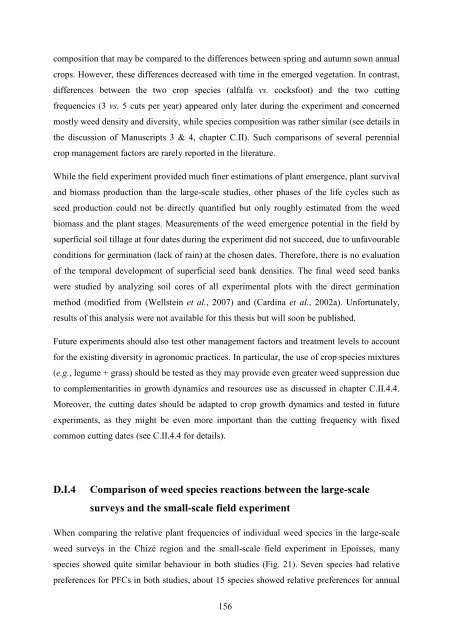Diversifying crop rotations with temporary grasslands - Université de ...
Diversifying crop rotations with temporary grasslands - Université de ...
Diversifying crop rotations with temporary grasslands - Université de ...
You also want an ePaper? Increase the reach of your titles
YUMPU automatically turns print PDFs into web optimized ePapers that Google loves.
composition that may be compared to the differences between spring and autumn sown annual<br />
<strong>crop</strong>s. However, these differences <strong>de</strong>creased <strong>with</strong> time in the emerged vegetation. In contrast,<br />
differences between the two <strong>crop</strong> species (alfalfa vs. cocksfoot) and the two cutting<br />
frequencies (3 vs. 5 cuts per year) appeared only later during the experiment and concerned<br />
mostly weed <strong>de</strong>nsity and diversity, while species composition was rather similar (see <strong>de</strong>tails in<br />
the discussion of Manuscripts 3 & 4, chapter C.II). Such comparisons of several perennial<br />
<strong>crop</strong> management factors are rarely reported in the literature.<br />
While the field experiment provi<strong>de</strong>d much finer estimations of plant emergence, plant survival<br />
and biomass production than the large-scale studies, other phases of the life cycles such as<br />
seed production could not be directly quantified but only roughly estimated from the weed<br />
biomass and the plant stages. Measurements of the weed emergence potential in the field by<br />
superficial soil tillage at four dates during the experiment did not succeed, due to unfavourable<br />
conditions for germination (lack of rain) at the chosen dates. Therefore, there is no evaluation<br />
of the temporal <strong>de</strong>velopment of superficial seed bank <strong>de</strong>nsities. The final weed seed banks<br />
were studied by analyzing soil cores of all experimental plots <strong>with</strong> the direct germination<br />
method (modified from (Wellstein et al., 2007) and (Cardina et al., 2002a). Unfortunately,<br />
results of this analysis were not available for this thesis but will soon be published.<br />
Future experiments should also test other management factors and treatment levels to account<br />
for the existing diversity in agronomic practices. In particular, the use of <strong>crop</strong> species mixtures<br />
(e.g., legume + grass) should be tested as they may provi<strong>de</strong> even greater weed suppression due<br />
to complementarities in growth dynamics and resources use as discussed in chapter C.II.4.4.<br />
Moreover, the cutting dates should be adapted to <strong>crop</strong> growth dynamics and tested in future<br />
experiments, as they might be even more important than the cutting frequency <strong>with</strong> fixed<br />
common cutting dates (see C.II.4.4 for <strong>de</strong>tails).<br />
D.I.4 Comparison of weed species reactions between the large-scale<br />
surveys and the small-scale field experiment<br />
When comparing the relative plant frequencies of individual weed species in the large-scale<br />
weed surveys in the Chizé region and the small-scale field experiment in Epoisses, many<br />
species showed quite similar behaviour in both studies (Fig. 21). Seven species had relative<br />
preferences for PFCs in both studies, about 15 species showed relative preferences for annual<br />
156

















